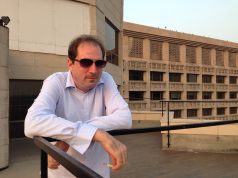“never send to know for whom the bells tolls; it tolls for thee.” – Devotions Upon Emergent Occasions, Meditation XVII: Nunc Lento Sonitu Dicunt, Morieris, John Donne (1572 – 1631)
The previously covert and low intensity war between the entrenched interests of the post-Soviet Ukrainian system, who for the past two post-revolutionary years had bided their time, and those that came of age during the revolution, has finally broken out into the open.
Battle openly rages as the old guard sees weakness and limited ambition for reform among the national political hierarchy. They now openly take the fight to the crusading reformers.
It is a battle that will rage openly for the next six–eight months, for that is as long as Ukraine can survive without IMF assistance. This lifeline is likely to be withheld until the fog of political war lifts. Although this battle may therefore have a foreseen shelf life, the war of which it is a part will continue for many years to come.
The lack of political ideology and absence of will to reform within the highest circles of national leadership and across the parliamentary parties and factions spectrum is now laid bare.
A reader may rightly ponder just how long reformist, anti-corruption, and democracy advocates such as Mustafa Nayem, Serhiy Leshchenko, and numerous others of similar ideology and moral fortitude, remain within their parties and political factions and retain their integrity and perceived moral high ground.
Clearly, it seems that removing them in a similar manner to Messrs Tomenko and Firsov under Article 81 of the Constitution of Ukraine (a party/faction loyalty clause) is currently seen as far too problematic given their high domestic and international profiles – at least for now.
Yet if the leading reformist parliamentarians left their current political homes, how many other morally upright and ethically sound new MPs would follow them? Would there be enough to cripple any faction or party, thus perhaps forcing elections far sooner than the anticipated parliamentary collapse in Autumn 2016/Spring 2017? Should the reformers leave their political parties and factions en masse? Would it have sufficient resonance to change Western minds regarding early parliamentary elections?
The key question is not only when this eventuality will finally occur, but also where the reformers go.
For those newly minted reformist parliamentarians, the “when” will depend upon whether they are subjected to Article 81 of the Constitution of Ukraine and thus exiled from their parties, or whether their moral code forces them to leave voluntarily, or the confirmation of the timing of early parliamentary elections provide a platform to depart their current berths.
The reform-orientated parliamentarians can have little faith in retaining any given a position on any party list under the proportional representation system now that law 3700 has become statute. This new statute, to go to the extremes, theoretically provides that a political party can stuff the top half of its party list with reformers that have traction with the public. They can then fill the bottom half with odious hangovers from post-Soviet oligarchic politics. Once the Central Election Commission has recognised the ballot result, they can then strike down the reformers en masse, leaving the seats to be filled by the loathsome – all quite lawfully.
As it is normally easier to effect change from the inside rather than the outside, most will try and remain where they currently are for as long as possible.
The question of where the reformers would go is somewhat unclear, particularly for those that have already left or been expelled by their political parties and now sit as independents, having avoided political death under Article 81 of the Constitution that befell Messrs Tomenko and Firsov.
Some may decide to remain within their current party structures and fight the fight they believe to be right from within the bellies of those political parties and/or factions.
Others may gravitate from their current political parties to others more aligned with their vision for Ukraine. For example, it is not beyond the realms of possibility that some in Block Poroshenko or the People’s Front would be drawn to Samopomich – this despite Samopomich having excommunicated the outstanding Hanna Hopko, a national reformist icon.
Some may head for the NGO turned political party Democratic Alliance. It was an outstanding NGO, part financed by Carnegie, with many of its members subsequently trained in local governance, law and civil activism. Had it not been for the internal decision to move from NGO to political party at the height of the Yanukovych brutality towards civil society in order to claim political repression should it be targeted, it would still remain one of the best NGOs in Ukraine, rather than one of the least known political parties. A political party to join or co-opt for the icons of Ukrainian reform, perhaps?
Maybe the Movement for Cleaning now associated with Governor Saakashvili will move from being a political movement to become a political party. Although this entity predates any involvement from the Odessa Governor, it is now broadly associated with him. That said, the Governor may create his own entity, for the Movement for Cleaning is not internally designed to accommodate the leadership model, nor style, that the Governor requires, for it operates on the horizontal and not the vertical in its decision making.
Perhaps any number of the ‘reformer High Chamberlains’ will create their own entities. The reformist church is not short of individual reformist icons – it lacks an overarching roof and strong reformist institutions.
There are several other established reformist possibilities that may directly enter the political fray too, but the point has been made – The church of reform in Ukraine is a broad church indeed, yet comprises of reformist High Chamberlains, individual icons and a diverse congregation.
There are other issues to consider aside from the current individual reform icons and the personality clashes that may occur under one political reformist church roof. These are also more fundamental issues within the reformist congregation and their constituent groups that internal and external punditry of Ukraine seems to politely choose to ignore, or is simply ignorant of.
Reform is a broad church in Ukraine, and thus has its schisms over the interpretation of its scripture.
How to reconcile the genuine reformers of the political left with those genuine reformers of the political right if a cohesive, effective and robust reform political entity is to emerge in a fight for wider constituency support?
Genuine democracy and rule of law reformers they may all be, yet their final designs are quite different with regard to the contemporary, modern state they want to build. A common desire to vanquish the demons of post-Soviet Ukraine may be a shared goal, but can they remain solid under a single reform roof long enough to put in place the required reform mechanisms, without falling from grace over the future paths of such mechanisms?
Can the High Chamberlains, individual icons, political left and political right of Ukrainian reform, all worship and spread the reformist gospel from under the same roof at all, despite their equally genuine reformist DNA?
It is very lazy thinking and pitiful analysis to lump them all together as a homogeneous reformist church that will have no internal weaknesses and schisms, but that will simply blaze a robust path out of the darkness and into the light for Ukraine to follow.
Perhaps they can all gather under the same reformist roof, perhaps not – but it will be problematic. The concept of reform common among all associated actors, icons and groups may be a cross cutting cleavage that unites them all – but would it be enough given many other differences? If it is enough, then for how long would it be enough?
There is a clear need, and it will undoubtedly occur, for a reformist political party dedicated to the reformist scripture to contest the next parliamentary elections, be they in autumn 2016 or spring 2017. The open question is perhaps how many reformist parties there will be. Under one roof it would seem likely the reformist church would sacrifice itself upon its own alter within two years (maximum). Alternatively, too many reform-worshipping but separate churches will play into the hands of the established Grey Cardinals of post-Soviet Ukrainian politics.
Whatever the outcome will be, the next question that would need to be answered for any successful truly reformist party/parties is with which other political entities they would join in any coalition – either in power or opposition – to prevent the Holy Grail taking on the appearance of a poisoned chalice.
Meanwhile, there will be political and institutional casualties during the remainder of the year as the overt battle between reformers and the old guard is fought. It remains to be seen who they will be, for “never send to know for whom the bells tolls; it tolls for thee.”




































